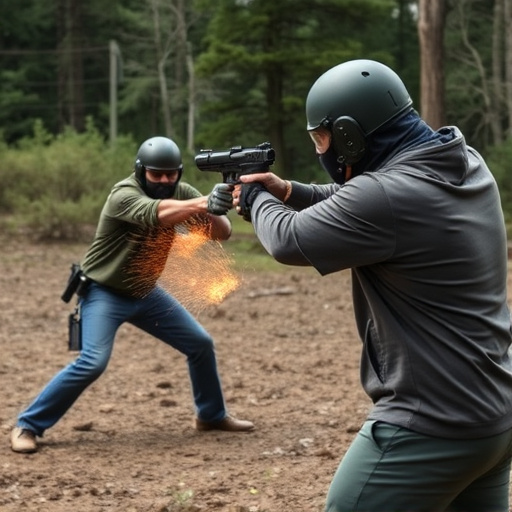This text examines the differences between projectile (e.g., tasers) and contact (e.g., batons) stun weapons, focusing on their immediate and long-term effects. While both temporarily incapacitate targets, projectile methods cause muscle contractions and disorientation through electric currents in the air, potentially leading to tissue damage over time. Contact weapons rely on direct impact, leaving visible marks but less likely to cause persistent neurological shocks; they can still result in localized injuries. Long-term neurological stun effects, often overlooked, may include sensory impairments, memory lapses, and chronic pain syndromes. Legal accessibility of stun weapons varies globally, with regulations prioritizing personal and public safety. Users should consider weapon selection based on situational dynamics, training, legal considerations, and the goal of ensuring safety without long-term neurological complications.
In the realm of personal safety, stun weapons have emerged as a controversial yet potent tool. This article delves into the intricate world of projectile and contact stun devices, offering a comprehensive overview. We explore the short-term versus long-term effects on the body, with a focus on the neurological impact—a key differentiator between projectiles and traditional stun guns. Additionally, we navigate legal considerations, providing insights for informed decision-making when choosing self-defense tools, especially considering the potential for lasting neurological stun effects.
- Understanding Projectile and Contact Stun Weapons: A Comprehensive Overview
- Short-Term vs Long-Term Effects of Stun Devices on the Body
- The Neurological Impact: Projectiles vs Traditional Stun Guns
- Legal Considerations and Regulations for Stun Weapon Ownership
- Choosing the Right Stun Device: Factors to Consider for Personal Safety
Understanding Projectile and Contact Stun Weapons: A Comprehensive Overview

Stun weapons are designed to incapacitate a target temporarily, and they fall into two primary categories: projectile and contact. Projectile stun weapons, such as stun guns or tasers, discharge an electric current through the air to reach the target, often causing muscle contraction and immediate disorientation. These devices typically have a range, after which their effectiveness diminishes significantly. On the other hand, contact stun weapons, like batons or impact weapons, rely on direct physical impact to deliver a shock. They make immediate contact with the target, resulting in pain compliance due to force transmission through the weapon to the body.
While both types serve similar purposes, understanding their differences is crucial, especially regarding long-term neurological stun effects. Projectile weapons may leave less physical evidence of use and can cause muscle breakdown and tissue damage over time due to repeated use. Contact weapons, while leaving visible marks, might not result in persistent neurological shocks but can lead to localized injury if misused or used excessively. The choice between these categories depends on various factors, including the situation’s dynamics, the user’s training, and the legal implications in their jurisdiction.
Short-Term vs Long-Term Effects of Stun Devices on the Body

The short-term effects of stun devices are well-documented and primarily focus on immediate physical incapacitation. When a stun gun or taser discharges, it delivers an electric current that disrupts muscle control in the target area, causing temporary paralysis and disorientation. This can be extremely effective for self-defense, as it provides users with a crucial window of opportunity to escape or subdue an attacker.
However, what often goes unnoticed is the potential for long-term neurological stun effects. While the immediate impact may resolve within minutes or hours, ongoing research suggests that exposure to high-voltage electrical impulses can have persistent effects on the body’s nervous system. Long-term neurological stun effects might include sensory impairments, memory lapses, and even chronic pain syndromes. These conditions can significantly impact an individual’s quality of life, underscoring the need for caution when considering the use of stun devices as a regular means of defense or law enforcement tool.
The Neurological Impact: Projectiles vs Traditional Stun Guns

Projectiles and traditional stun guns differ significantly in their neurological impact, with potential long-term effects on the human brain. Projectile weapons, such as stun arrows or bean bags, cause physical trauma upon impact, leading to immediate sensory overload and disruption of neural signaling in the targeted area. While these may result in short-term incapacitation, there is limited evidence suggesting persistent neurological damage from a single incident.
In contrast, traditional stun guns use electric current to disrupt brain function through overstimulation, causing temporary disorientation, muscle spasms, and memory lapses. The long-term neurological stun effects are a growing area of interest, with some studies indicating potential for prolonged cognitive impairment, including altered sensory perception and motor control in individuals exposed to repeated or prolonged stun gun use. These findings underscore the need for further research into the cumulative effects of both types of weapons on the brain.
Legal Considerations and Regulations for Stun Weapon Ownership

The legal landscape surrounding stun weapon ownership varies significantly across regions, reflecting complex debates about personal safety and public safety. In many countries, stun devices are classified as firearms or less-lethal weapons, subject to strict regulations. These include background checks, age restrictions, and permits for possession and use. The focus on regulating stun weapons is often centered around mitigating risks associated with their use, including potential long-term neurological stun effects.
Regulations also address where and how these devices can be carried and used, aiming to balance individual rights with community well-being. Some jurisdictions permit stun guns for self-defense within specific confines, while others ban them entirely due to concerns over misuse and the inherent risk of causing harm, especially when compared to non-lethal alternatives. Understanding local laws is crucial before considering ownership, as penalties for unauthorized possession can be severe.
Choosing the Right Stun Device: Factors to Consider for Personal Safety

When considering personal safety, choosing the right stun device involves several factors, especially when contrasting projectile and contact stun weapons. Projectile devices, like tasers, fire electrical charges over a distance, providing a temporary incapacitation. However, they pose risks of long-term neurological stun effects, as the high-voltage pulses can lead to muscle contractions and potentially severe bodily harm if not used properly.
On the other hand, contact stun weapons, such as stun batons or personal defense spray, require direct contact or proximity to the target. These methods offer more control and reduce the likelihood of accidental injury. While they may not have the same immediate impact as projectiles, proper use can still disable an attacker effectively. Consider factors like ease of use, range, and legal implications in your decision, ensuring you’re prepared for any situation while prioritizing safety above all else.
When considering the purchase of a stun weapon for personal safety, understanding the differences between projectile and contact stun devices is essential. While both designs offer protection, the article has highlighted key distinctions in their effectiveness and impact on the body, particularly focusing on the long-term neurological effects. Projectile weapons may cause more immediate but temporary stun, while contact stun guns deliver a powerful electric shock with potential for lasting sensory and motor impairments. Legal regulations vary widely, so it’s crucial to research local laws and choose a device that meets your safety needs while adhering to legal requirements. By weighing these factors, individuals can make informed decisions to protect themselves in various situations.
